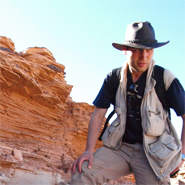Posted 16 December 2008
UCD dinosaur hunter uncovers new remains of prehistoric giants in the Sahara
Scientists on a month-long expedition to the Sahara desert have returned home in time for Christmas with more than they ever dreamed of finding.
The team, led by University College Dublin palaeontologist Nizar Ibrahim from the UCD School of Biology and Environmental Science, unearthed hundreds of fossils, including two possible new species of extinct animals.
Pictured far right, UCD palaeontologist, Nizar Ibrahim on expedition in the Sahara
The team composed of scientists from University College Dublin, The University of Portsmouth and the Université Hassan II in Casablanca have discovered what appears to be a new type of pterosaur and a previously unknown sauropod, a species of giant plant-eating dinosaur. Both would have lived almost one hundred million years ago. The expedition is part of a project undertaken by Nizar Ibrahim, who has already visited the area on previous trips and is an expert on North African dinosaurs.
The palaeontologists discovered a large fragment of the beak of a giant flying reptile (pterosaur) and a more than one metre long leg-bone from a sauropod, which indicates a massive animal of around 20 metres (65 feet) in length. The discovery of both is extremely rare and particularly unusual to come out of Cretaceous rocks in Morocco. Ibrahim said: “Finding two exciting specimens in one expedition is remarkable, especially as both might well represent completely new species.”
Dr David Martill, a reader in Palaeobiology at the University of Portsmouth, added: “We find just one plant eater for every hundred meat eating dinosaurs here. It’s extremely rare to find one specimen in this region and to find one this large is very exciting. It’s a major discovery.”
Nizar Ibrahim, an Ad Astra research scholar at University College Dublin (UCD) will undertake the detailed analysis of the sauropod bone and the other remains. He expects the sauropod is a new species and genus of the sauropd family.
“From our initial examination on site, we’re almost certain that we have a new species on our hands,” said Ibrahim, who will spend the next six months examining the fossils and writing about them for his PhD thesis, “and it looks as if the pterosaur is also a new genus and species”.
Pterosaur remains are uncommon because their bones, optimised for flight, were light and flimsy so they are seldom well preserved. Pterosaur finds in Africa are particularly rare with only two or three significant discoveries.
Ibrahim said: “Most discoveries are just fragments of teeth and bone so it was thrilling to find a large part of a beak and this was enough to tell us we probably have a new species on our hands.”
The team spent a month in the desert and travelled over a thousand miles by Landrover in an epic overland trip which has taken them through the Atlas mountains and has seen them battling sandstorms and floods in an Indiana Jones-style quest.
Having discovered the giant sauropod bone they had to return to the nearest town to get more water and plaster with which to protect it, a trip which involved crossing a flooded river in their Landrover at night with water coming in through the doors.
During their journey they were cut off from civilisation for 4 days when heavy rain in the Atlas mountains flooded the river Ziz. To retrieve the bone they had to manhandle the fossil in its plaster jacket down the side of a mountain, clearing thousands of stones to make a safe path to carry it on a wooden stretcher.
“We really weren’t sure we would make it out of the desert with the bone, but we had worked so hard to find it so there was no way I was leaving it behind. It took us 5 days to get the bone out of the ground and down the mountain – and that was not the end of our problems” says Ibrahim.
Dr Martill said: “When we had managed to get the bone in the Landrover the extra weight meant we kept sinking in the sand dunes and on several occasions everybody except the driver had to walk while we negotiated difficult terrain. Our journey home was equally eventful. While crossing the Atlas mountains we got caught in a snowstorm and total whiteout. But it’s all been worth it.”
The team were also excited to discover some rare dinosaur footprints, including some that record several animals walking along the same trail.
As well as discovering hundreds of dinosaur teeth, they also unearthed bits of giant crocodiles and turtles and some new species of fish.
“It’s amazing to think that millions of years ago the Sahara was in fact a lush green tropical paradise, home to giant dinosaurs and crocodiles and nothing like the dusty desert we see today. Even to a palaeontologist dealing in millions of years it gives one an overwhelming sense of deep time,” said Ibrahim.
Prof Samir Zouhri, head of the Department of Geology at the Université Hassan II in Casablanca remarked: “Nizar Ibrahim is a very determined researcher and I knew that he would have success on this trip, but these fossils exceeded our expectations - It is wonderful that we have made these siginficant discoveries and that they will return to Morocco for display after study in Dublin.”
The sauropod and the pterosaur were found in south-east Morocco, near the Algerian border. The giant sauropod bone will arrive in Dublin in January.
